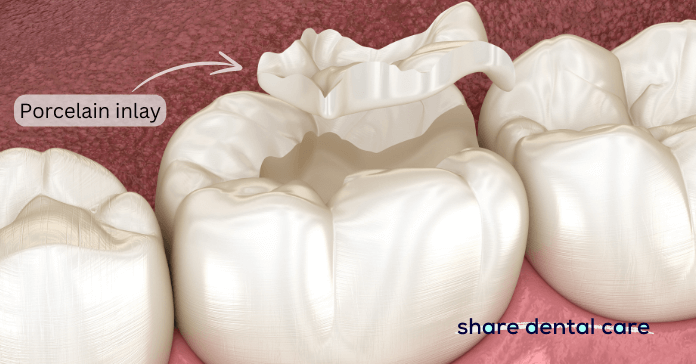When it comes to our oral health, we all want the best possible treatment available. That’s why porcelain fillings have become increasingly popular in recent years for those looking for a more aesthetically pleasing and functional solution. In this blog post, we’ll take a closer look at porcelain fillings and why they may be the right choice for you.
What are Porcelain Fillings?
Porcelain fillings, also known as porcelain inlay, onlay, or ceramic fillings, are a type of dental restoration used to repair damaged or decayed teeth. They are made from a tooth-colored material called porcelain, which is highly durable and resistant to staining. While composite fillings can also be color-matched to your natural teeth, they tend to stain more easily and are not as durable as porcelain.
Porcelain inlay and onlay are custom-made in a dental laboratory based on an impression of your tooth, ensuring a perfect fit. Unlike traditional amalgam (silver) fillings, porcelain fillings blend seamlessly with your natural teeth, making them virtually unnoticeable. This makes them ideal for those who want a more natural-looking smile.
Benefits of Porcelain Fillings
There are several advantages to choosing porcelain fillings over traditional options:
- Aesthetic appeal: As mentioned earlier, porcelain fillings blend in with your natural teeth, giving you a more aesthetically pleasing smile.
- Durability: Porcelain is a durable material that can withstand the forces of chewing and normal wear and tear, making it a long-lasting option for dental restorations.
- Stain-resistant: Unlike composite fillings, porcelain does not stain easily, meaning your restoration will maintain its natural color over time.
- Better fit: Since porcelain inlay and onlay are custom-made, they fit perfectly into the cavity and provide a tight seal to prevent further decay.
- Biocompatibility: Porcelain is biocompatible with natural teeth, meaning it will not cause any adverse reactions or allergies.

Porcelain vs. Composite fillings
While porcelain fillings offer numerous benefits, composite fillings are also a popular option. Both materials offer aesthetic benefits and can be matched to the natural color of your teeth.
Composite fillings are preferred for small cavities and are more affordable. However, they are not as durable as porcelain and may need to be replaced more frequently. They may also be more prone to staining over time.
On the other hand, porcelain inlay and onlay are ideal for large cavities and are more resistant to wear and tear. They may be more expensive initially, but they can save you money in the long run by reducing the need for frequent replacements.
“How long do white fillings last?” The longevity of white fillings depends on various factors, such as the location of the filling, the size of the filling, and individual oral hygiene habits. On average, composite fillings can last between 5-7 years, while porcelain fillings have a longer lifespan, lasting up to 15 years or more with proper care.
Ultimately, the best type of filling for you will depend on several factors; the location of the filling, your budget, and your individual dental needs. Your dentist can help you make an informed decision based on your specific situation.
How is the Procedure Performed?
The process of getting porcelain inlay and onlay generally involves two visits to the dentist. During the first visit, your dentist will remove any decay from your tooth and take an impression. This impression is then sent to a dental lab where your custom-made filling is created.
During your second visit, your dentist will check the fit of the filling and make any necessary adjustments before bonding it to your tooth.
Are there any Disadvantages to Porcelain Fillings?
While porcelain fillings offer numerous benefits, there are a few potential downsides to consider:
- Cost: Porcelain inlay and onlay can be more expensive than other options due to the custom-made nature and high-quality materials used.
- Brittleness: Porcelain is a brittle material and may be more prone to cracking or chipping compared to other filling materials. However, with proper care, porcelain inlay and onlay can last for many years without issue.
Caring for Porcelain Inlay or Onlay
To ensure the longevity of your porcelain fillings, it’s important to take good care of them. This includes practicing good oral hygiene habits such as brushing twice a day, flossing daily, and visiting your dentist regularly for cleanings and checkups.
Avoid using your teeth as tools or biting down on hard objects like ice or pens, as this can put unnecessary stress on the filling and may cause it to crack or chip. If you grind your teeth, your dentist may recommend wearing a night guard to protect both your natural teeth and fillings while you sleep.
If you notice any issues with your porcelain filling, such as a crack or sharp edge, contact your dentist right away. They can assess the problem and make any necessary repairs to keep your filling in good condition.
Conclusion
Porcelain fillings are an excellent choice for restoring teeth damaged by decay or trauma. They offer numerous benefits, including durability, stain resistance, and natural appearance.
With proper care and maintenance, porcelain inlay and onlay can provide long-lasting results that will keep your smile looking its best. So, if you need a filling, consider discussing porcelain fillings with your dentist to determine if they are the right choice for you.